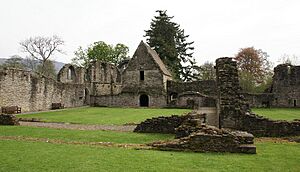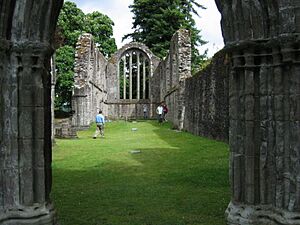Inchmahome Priory facts for kids
|
Abbey ruins
|
|
| Monastery information | |
|---|---|
| Established | 1238 |
| People | |
| Founder(s) | Earl of Menteith, Walter Comyn |
| Official name | Inchmahome Priory |
| Type | Ecclesiastical: priory |
| Designated | 31 December 1921 |
| Reference no. | SM90169 |
Inchmahome Priory is an old building located on Inchmahome. This is the biggest of three islands in the middle of the Lake of Menteith. It is found near Aberfoyle in Scotland.
The name "Inchmahome" comes from an old Scottish language called Gaelic. It means "island of St Colmaig."
Contents
What is Inchmahome Priory?
This priory was started in 1238 by a powerful Scottish noble. His name was Walter Comyn, the Earl of Menteith. He built it for a small group of Augustinian monks, also known as the Black Canons. The Comyn family was very important in Scotland at that time. They even had a large house on Inch Talla, another island nearby. Some people think there might have been a church on Inchmahome before the priory was built.
Famous Visitors to the Priory
Many important people visited Inchmahome Priory over the years.
Kings and Queens
- King Robert the Bruce visited three times. He came in 1306, 1308, and 1310. His visits were likely for political reasons. The first leader of the priory had supported the English king, Edward I.
- In 1358, Robert II, who would later become king, stayed at the priory.
- In 1547, Queen Mary was just four years old. She hid at the priory for a few weeks. This was after the Scottish army lost badly at the Battle of Pinkie. This time was part of a conflict known as the Rough Wooing.
The Priory's Decline
Over time, the number of monks in Scotland began to decrease. This happened faster in the 1500s. Local landowners started choosing the leaders of the priories. These new leaders often did not share the same religious goals as the monks.
In 1547, John, Lord Erskine became the leader of Inchmahome Priory. He later also led other important abbeys. After the Scottish Reformation, new priests were no longer trained. Religious lands and buildings slowly became owned by regular people. This led to the priory's decline.
In 1606, the land and buildings went to the Erskine family. Later, they went to the Marquess of Montrose. In 1926, the 6th Duke of Montrose gave the priory to the care of the Scottish government.
What Remains Today
Today, most of the priory buildings are ruins. However, much of the original structure from the 1200s is still there. Historic Environment Scotland now looks after the priory. They keep it safe and preserve it as a scheduled monument.
You can visit the priory by boat. A boat operates between March and September. It leaves from a pier at the Port of Menteith nearby.
Burials at the Priory
See also
 In Spanish: Priorato de Inchmahome para niños
In Spanish: Priorato de Inchmahome para niños
- Scheduled monuments in Stirling




